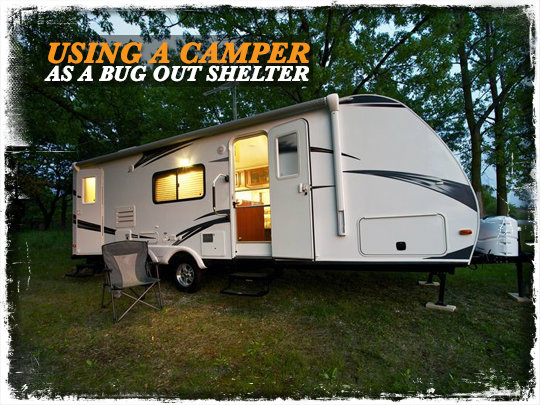
A previous article talked about travel trailers/campers, and motor homes as bug-out-vehicles, but this article will discuss campers as bug-out shelters. What this would mean however, is placing a camper at your bug-out location before the crisis struck. A camper would likely be less expensive than building a cabin/house and a camper would offer more protection than a canvas or nylon tent.
Trying to pull a camper as you evacuate during a crisis may be problematic. You may not even be able to bug-out in a vehicle let alone with a camper attached, but if you can get out on foot, and make it to your bug-out shelter/camper then you have increased your chances of survival dramatically.
A camper is self-contained and most will have on board fresh water tanks, gray water tanks, and black water tanks. A generator could easily supply all of the electricity needed for the water pump, water heater, lights, and refrigeration. You would need an ample supply of propane for cooking inside of the trailer and for heating the trailer. The best part of all is that you can pick up and leave for another location if needed however.
The obvious problems are obtaining land to park the camper on now, well ahead any SHTF scenarios, and of course enough supplies to sustain you for an extended period. You would need a generator and fuel, propane and a water source. You could filter a water source and then fill the fresh water tanks and then purify the water or not use the tanks at all depending on the situation.
Keep in mind you would have a water pump and water heater on board that would make life much easier if you could fill the fresh water tanks. The most important aspect is you would have a sturdy shelter that would protect you from the elements and four legged predators, insects and reptiles.
Your camper/bug-out-shelter would need to be inland far enough, so you could use it during a natural disaster such as when a hurricane strikes. Pick your location carefully and study the history of the area for frequencies of wild fires and tornadoes as well.
Cache sites will be important, because you do not want to store too many supplies inside the camper in the event it is broken into. The camper can be camouflaged like any shelter using netting or natural surroundings. You would not want to cut brush to pile around the shelter to try and hide it, because cut vegetation will of course turn brown in a few days giving away the location. You can take advantage of living camouflage however, but leave a small footprint, so as not to give anyone a reason to snoop.
It will take considerable planning, but it can be done and it would be much easier than trying to build a structure and then trying to figure out a way to supply power, water and other infrastructure to the shelter. A camper carries its infrastructure with it, so all you need is a power source such as a generator.
You can purchase additional equipment to use with your camper such as a small refrigerator and/or freezer, water heaters and so on. Some campers are set up with generators so switching over is simply a flick of a switch. Campers are either 30 or 50 amp and they usually come with a 10 gauge power cord. If it is a 30 amp supply, it can be easily adapted to a standard receptacle on the generator. Campers that are 50 amps will require a 240 volt power source to run the air conditioners for example.
Keep in mind most refrigerators in campers can operate using propane and some are automatic, which means they can switch over when one source is dominate, and many hot water heaters in campers can operate using either source as well.
A camper is the perfect shelter in a lot of ways, while it does have its drawbacks, it is certainly better suited for disasters than a tent or ad hoc shelter you put together using materials from your environment. It is something to think about, and remember you need a shelter first and foremost in most situations, and it needs to be adequate so it can withstand the rigors of the environment in which you find yourself.